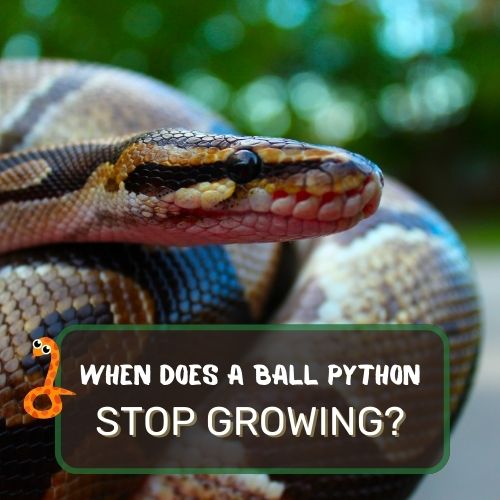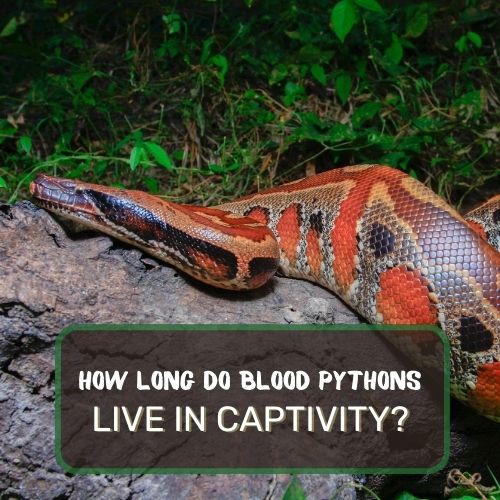
When you first lay eyes on a ball python, one question that often springs to mind is, “When does a ball python stop growing?”
It’s a question that piques the curiosity of both seasoned reptile enthusiasts and new python parents alike.
In this comprehensive article, we delve deep into the growth journey of these mesmerizing creatures.
From the early days of hatchlings to the majestic stature of adults, we explore the myriad of factors influencing their growth.
By diving into their diet, genetics, environment, and care, we provide insights that not only answer the burning question but also guide you in ensuring optimal health for your slithery companion.
Table of Contents
When Does a Ball Python Stop Growing?
Ball pythons, renowned for their docile nature and unique patterns, undergo most of their rapid growth in the initial years of their life. Typically, they reach maturity between 3 to 5 years of age. By this time, they’ve achieved most of their full length, ranging between 3 to 5 feet. However, it’s essential to note that while their fastest growth spurt occurs during these early years, ball pythons never truly cease growing.
As they age, their growth rate significantly slows down, adding only a few inches or even fractions of an inch to their length over the years.

The Importance of Monitoring Ball Python Growth
Ah, the ball python! One of the most popular reptilian pets, and for good reason. Their docile nature, combined with their mesmerizing patterns, makes them a favorite among reptile enthusiasts.
But, like any pet, understanding their growth patterns is crucial. So, why is it so vital to keep an eye on how your slithery friend grows?
The Significance of Knowing the Growth Rate
Imagine you’re a first-time ball python owner. You’ve got your habitat set up, you’re feeding your python regularly, and everything seems to be going smoothly.
But then you start to wonder, “Is my python growing at the right pace?” This is where understanding the growth rate becomes essential.
Knowing the typical growth rate of a ball python can serve as a benchmark. It helps you gauge whether your pet is on the right track or if there might be underlying issues.
For instance, if your python is growing too quickly, it might be overfed. On the other hand, if it’s growing too slowly, there could be potential health concerns.
How Growth Patterns Can Indicate the Health and Well-Being of the Python
Let’s dive a bit deeper. Think of growth patterns as a health report card for your python. Just as you’d be concerned if a child wasn’t growing at the expected rate, the same goes for your ball python.
A steady growth indicates that your python is getting the right amount of nutrition and is living in a stress-free environment. On the flip side, erratic growth can be a red flag.
For example, if your python has been growing steadily and then suddenly stops, it might be facing issues like improper diet, stress, or even illness.
Moreover, understanding growth patterns can also help in breeding. If you ever decide to breed your ball python, knowing when it reaches sexual maturity (which is closely tied to its growth) is crucial.

Factors Influencing Ball Python Growth
Just like humans, several factors play a role in how these creatures grow. Let’s delve into some of the primary influencers that determine the growth trajectory of your ball python.
Role of Health and Eating Habits
First and foremost, health and diet are paramount. Just as you wouldn’t thrive on junk food alone (tempting as it might be), a ball python’s growth is significantly influenced by its diet. These reptiles need a balanced diet, primarily consisting of rodents.
The frequency, size, and type of their meals can make a world of difference. Overfeeding can lead to rapid growth and obesity, while underfeeding can stunt growth and lead to health issues. It’s all about striking the right balance!
Importance of Proper Husbandry
Next up, let’s talk about husbandry. If you’re scratching your head wondering what that is, think of it as the overall care and environment you provide for your python.
This includes the size of the enclosure, the temperature, humidity, and even the substrate used. A proper environment mimics their natural habitat, ensuring they’re stress-free and comfortable.
A stressed python can refuse to eat or even fall ill, both of which can hinder growth. So, ensuring top-notch husbandry is akin to providing a five-star hotel experience for your pet!
Genetic Factors and Individual Variations
Lastly, just as you might’ve inherited your great-grandma’s eyes or your uncle’s height, genetics play a role in ball python growth. Some pythons might naturally be larger due to their genetic makeup, while others might be on the smaller side.
It’s essential to remember that each ball python is unique. While growth charts and averages provide a guideline, individual variations are bound to occur. It’s these differences that make each python special in its own right!

Hatchling Ball Pythons
These tiny, delicate beings embark on a journey full of growth, exploration, and discovery from the moment they break free from their eggs. Let’s dive into the captivating world of hatchling ball pythons.
Size and Weight of Hatchlings
When ball pythons first emerge from their eggs, they’re surprisingly small. Typically, they measure between 10-16 inches in length and weigh around 40-75 grams.
It’s a humble start for a creature that will grow to be several feet long in its adulthood.
The Hatching Process and Their First Venture into the World
The hatching process is a testament to nature’s wonder. After about 55 to 60 days of incubation, these little pythons start their journey by making a small slit in the egg using a specialized “egg tooth.”
Over the next 24 to 48 hours, they slowly emerge, absorbing the remaining yolk for nourishment. Their first venture into the world is cautious, filled with wonder and a touch of vulnerability.
The Importance of Tight Spaces for Security
In the wild, hatchlings are easy prey. This vulnerability has instilled in them an instinctual love for tight spaces. These spaces, be it crevices, burrows, or tight coils of their mother, offer a sense of security.
In captivity, providing hiding spots or tight spaces can help reduce stress and mimic their natural environment, ensuring they feel safe and protected.
Feeding Habits and Frequency
Hatchlings have a voracious appetite, which is essential for their rapid growth. However, they don’t start eating immediately.
They usually begin their feeding journey after their first shed, which occurs within 5-10 days post-hatching. Their initial diet consists of small prey, like pinky mice.
As they grow, the size of their meals increases. In the first few months, feeding them once every 5-7 days is ideal.
The Process of Sexing Hatchlings
Determining the sex of hatchling ball pythons can be a delicate process. It involves a method called “probing,” where a small probe is inserted into the vent to check the depth. Males have longer pockets than females.
While it’s a common method, it requires experience and care to ensure the hatchling isn’t harmed.
Growth Rate in the Initial Months
The initial months of a ball python’s life are marked by rapid growth. With proper feeding and care, they can almost double in size in just a few months. This growth spurt is essential, setting the foundation for their adult size and overall health.

Juvenile Ball Pythons
The journey from a hatchling to a juvenile ball python is akin to a teenager stepping into young adulthood. It’s a phase of rapid growth, exploration, and setting the stage for their adult life.
Let’s delve into the intriguing phase of juvenile ball pythons and understand their needs and behaviors.
Size and Weight Variations
As ball pythons transition from hatchlings to juveniles, they experience a significant increase in size and weight.
Typically, by the time they reach the juvenile stage, which is around 6 months to a year, they measure between 20 to 40 inches and weigh between 300 to 1000 grams.
It’s a phase of rapid growth, and with the right care, they continue to thrive.
Differences in Growth Rates Between Males and Females
Just like in many species, male and female ball pythons don’t grow at the same rate. Generally, males tend to grow at a slightly faster pace and reach maturity quicker than females.
While the differences aren’t stark, it’s essential to be aware of these variations, especially if you’re considering breeding in the future.
Transitioning from Mice to Rats
Diet plays a pivotal role in the growth of juvenile ball pythons. As they grow, their dietary needs change. While hatchlings start with pinky mice, juveniles require more substantial meals.
This is the phase where many python owners transition from feeding mice to rats. Rats offer more nutrition and are an excellent choice to support the python’s rapid growth during this stage.
Appropriate Feeding Frequency and Prey Size
With growth comes an increase in appetite. However, it’s crucial to strike a balance. Overfeeding can lead to obesity, while underfeeding can stunt growth. For juveniles, feeding them once every 7-10 days is ideal.
The prey size should be roughly the same diameter as the python’s widest part, ensuring they get adequate nutrition without the risk of regurgitation.
Housing Needs and Considerations
As juveniles grow, their housing needs change. The enclosure that was perfect for a hatchling might become cramped for a juvenile.
It’s essential to provide them with a larger space, ensuring they have room to move, explore, and grow.
Additionally, the importance of hiding spots remains. Providing them with larger hides and ensuring the temperature and humidity are optimal is crucial for their well-being.

Subadult Ball Pythons
Stepping into the realm of subadulthood, ball pythons are no longer the tiny hatchlings or the rapidly growing juveniles. They’re on the cusp of adulthood, with their own unique set of needs and characteristics.
Let’s delve into the world of subadult ball pythons and understand what makes this phase distinct.
Size and Weight Based on Gender
As subadults, ball pythons continue to grow, but at a slightly slower pace than their juvenile days.
Typically, males at this stage can weigh between 800 grams to 1.2 kilograms, while females, being generally larger, range from 1 to 1.5 kilograms.
In terms of length, males can be around 2.5 to 3 feet, whereas females can stretch from 3 to 4 feet.
Breeding Readiness and Considerations
Subadulthood is when breeding considerations come into play, especially for males. While females might still need more time to mature, many males are ready to breed by the end of this phase.
However, it’s essential to consider both weight and age. A male might weigh enough but might still be too young, leading to ineffective breeding.
The Dangers of “Power Feeding”
In the quest to speed up growth or prepare pythons for breeding, some owners resort to “power feeding” – offering larger or more frequent meals to accelerate weight gain. This practice can be detrimental.
It can lead to obesity, shorten the python’s lifespan, and even result in liver or kidney issues. It’s always best to allow pythons to grow at their natural pace.
Tools to Track Python’s Weight
Monitoring your python’s weight is crucial during this phase. Regular weigh-ins using a digital scale can help track growth and ensure they’re on the right path.
Maintaining a growth chart or a journal can be beneficial, providing insights into their growth patterns and helping spot any potential issues early on.
Housing Considerations for Subadults
As they inch closer to their adult size, subadult ball pythons require spacious enclosures. A cramped space can lead to stress, reduced appetite, and even health issues.
Ensure the enclosure is large enough for them to move and stretch comfortably. Additionally, the basics remain vital: optimal temperature, humidity, and appropriate hiding spots to ensure they feel secure.

Adult Ball Pythons
Ah, the grandeur of adulthood! As ball pythons transition into their adult phase, they showcase their true majesty.
This stage, marked by stability and maturity, comes with its own set of intricacies. Let’s dive deep into the world of adult ball pythons and explore the nuances of their care and characteristics.
Achieving Full Length and Factors Influencing It
By adulthood, ball pythons have achieved most of their full length, typically ranging between 3 to 5 feet. However, several factors influence this growth.
Genetics play a pivotal role; just as some families might have taller members, some pythons naturally grow larger due to their genetic lineage.
Diet and overall health during their earlier stages also significantly impact their adult size. And, of course, environmental factors, such as the quality of husbandry, can either support or hinder their growth.
Feeding Habits and Frequency for Adults
Gone are the days of rapid growth and voracious appetites. Adult ball pythons have more stable feeding habits. Typically, they can be fed once every 10-14 days.
The prey size should still match the python’s girth, but now, larger rats become the staple diet. It’s essential to monitor their weight and adjust feeding frequency accordingly, ensuring they maintain a healthy weight.
Factors Influencing a Ball Python’s Adult Size
Beyond genetics, several factors can influence how large a ball python becomes in adulthood. Nutrition is paramount; a well-balanced diet during their hatchling, juvenile, and subadult phases sets the foundation.
The quality of care, including the right temperature, humidity, and stress-free environment, also plays a significant role. Lastly, factors like illnesses or parasites during their growth phases can impact their adult size.
Breeding Considerations Based on Size and Age
When it comes to breeding adult ball pythons, both size and age matter. While males can breed once they weigh around 500 grams, females should ideally weigh at least 1,500 grams to ensure healthy breeding.
Age is equally crucial; younger pythons, even if they meet the weight criteria, might not be as effective or healthy breeders as slightly older ones.
The Importance of Health Over Size
In the world of ball pythons, bigger isn’t always better. While it’s fascinating to see a large, majestic python, health should always be the priority.
A smaller, healthier python is far more desirable than a larger one facing health issues. Regular check-ups, a balanced diet, and optimal living conditions ensure that your python, regardless of its size, leads a long, healthy life.

Conclusion
From the delicate early days of hatchlings to the grandeur of adulthood, you’ve discovered the myriad factors that influence their size and development.
Diet, genetics, environment, and care all play pivotal roles in shaping these magnificent creatures.
It’s clear that understanding their growth isn’t just about satisfying curiosity; it’s about ensuring their well-being and health throughout their life.
Remember, every ball python is unique. While guidelines and averages provide a roadmap, it’s the individual quirks and characteristics of your python that make the journey truly special.
As you continue your adventure with your slithery companion, let this knowledge guide you. Provide the best care, monitor their growth, and cherish every moment.
With your dedication and newfound knowledge, your ball python is set to lead a long, healthy, and fulfilling life. Keep learning, keep exploring, and let your passion for these incredible reptiles shine through!
More Asked Questions
Navigating the world of ball pythons can be filled with questions, especially as these creatures grow and evolve. Let’s address some of the most commonly asked queries about these fascinating reptiles.
How Can I Speed Up My Ball Python Growth?
While it’s tempting to want your ball python to grow quickly, it’s essential to prioritize their health over rapid growth. Overfeeding or “power feeding” can lead to health issues. The best approach is to provide a balanced diet, ensure optimal living conditions, and allow your python to grow at its natural pace.
How Long Do Baby Ball Pythons Take to Grow?
Baby ball pythons experience rapid growth in their initial months. By the time they transition to juveniles, around 6 months to a year, they’ve achieved a significant portion of their growth. However, they continue to grow, albeit at a slower pace, throughout their life.
How Often Should You Feed a Ball Python?
Feeding frequency varies based on the python’s age. Hatchlings should be fed every 5-7 days, juveniles every 7-10 days, and adults every 10-14 days. Always monitor their weight and adjust feeding accordingly.
Why Is My Ball Python So Small?
Several factors can influence a ball python’s size, including genetics, diet, health, and overall care. If you’re concerned about your python’s size, consult with a reptile veterinarian to rule out any health issues.
How Long Do Ball Pythons Grow in Captivity?
In captivity, with proper care, ball pythons can continue to grow throughout their life. While the most rapid growth occurs in their early years, they never truly stop growing. However, the growth rate significantly slows down as they age.




0 Comments